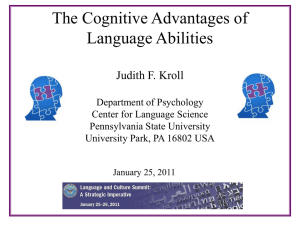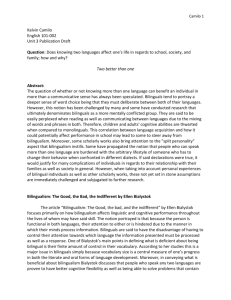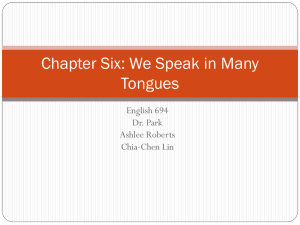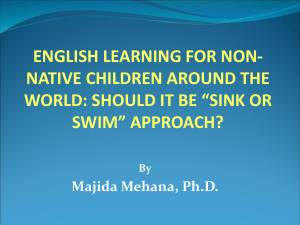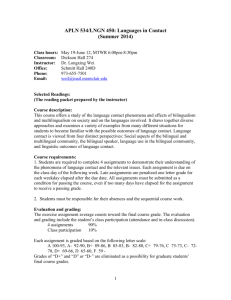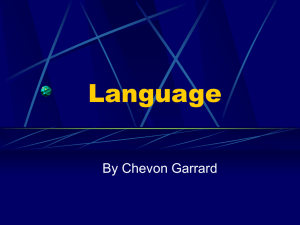The Cognitive Advantages of Balanced Bilingualism June 2000 by
advertisement
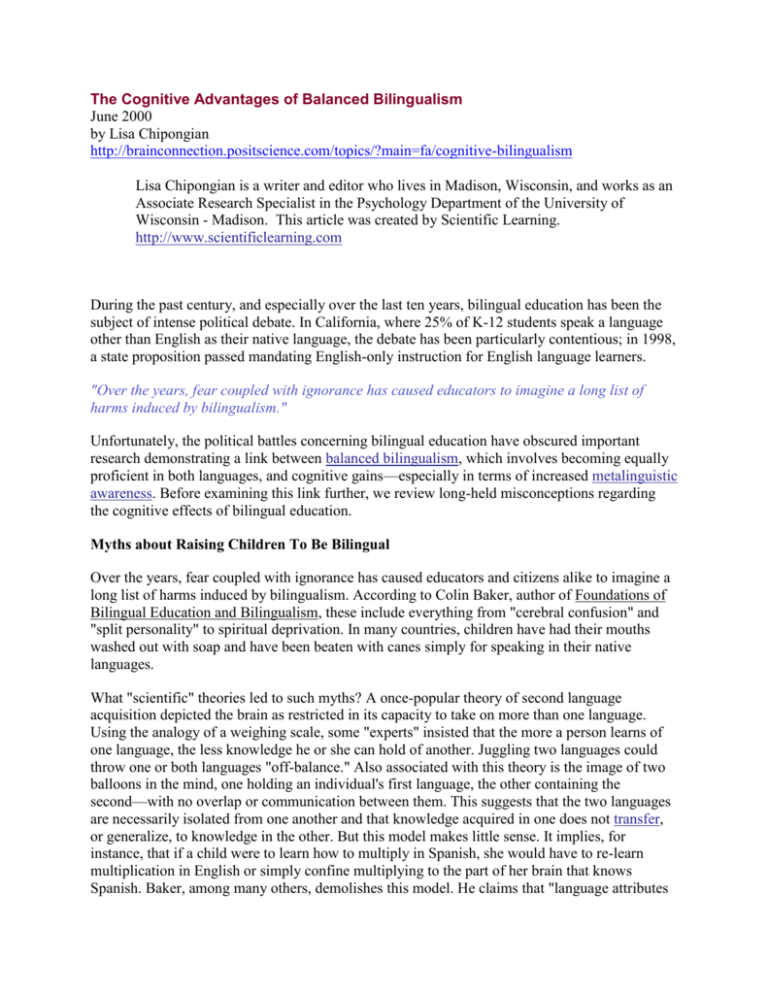
The Cognitive Advantages of Balanced Bilingualism June 2000 by Lisa Chipongian http://brainconnection.positscience.com/topics/?main=fa/cognitive-bilingualism Lisa Chipongian is a writer and editor who lives in Madison, Wisconsin, and works as an Associate Research Specialist in the Psychology Department of the University of Wisconsin - Madison. This article was created by Scientific Learning. http://www.scientificlearning.com During the past century, and especially over the last ten years, bilingual education has been the subject of intense political debate. In California, where 25% of K-12 students speak a language other than English as their native language, the debate has been particularly contentious; in 1998, a state proposition passed mandating English-only instruction for English language learners. "Over the years, fear coupled with ignorance has caused educators to imagine a long list of harms induced by bilingualism." Unfortunately, the political battles concerning bilingual education have obscured important research demonstrating a link between balanced bilingualism, which involves becoming equally proficient in both languages, and cognitive gains—especially in terms of increased metalinguistic awareness. Before examining this link further, we review long-held misconceptions regarding the cognitive effects of bilingual education. Myths about Raising Children To Be Bilingual Over the years, fear coupled with ignorance has caused educators and citizens alike to imagine a long list of harms induced by bilingualism. According to Colin Baker, author of Foundations of Bilingual Education and Bilingualism, these include everything from "cerebral confusion" and "split personality" to spiritual deprivation. In many countries, children have had their mouths washed out with soap and have been beaten with canes simply for speaking in their native languages. What "scientific" theories led to such myths? A once-popular theory of second language acquisition depicted the brain as restricted in its capacity to take on more than one language. Using the analogy of a weighing scale, some "experts" insisted that the more a person learns of one language, the less knowledge he or she can hold of another. Juggling two languages could throw one or both languages "off-balance." Also associated with this theory is the image of two balloons in the mind, one holding an individual's first language, the other containing the second—with no overlap or communication between them. This suggests that the two languages are necessarily isolated from one another and that knowledge acquired in one does not transfer, or generalize, to knowledge in the other. But this model makes little sense. It implies, for instance, that if a child were to learn how to multiply in Spanish, she would have to re-learn multiplication in English or simply confine multiplying to the part of her brain that knows Spanish. Baker, among many others, demolishes this model. He claims that "language attributes are not apart in the cognitive system, but transfer readily and are interactive." "Recent research has demonstrated that positive cognitive gains are associated with learning a second language in childhood." Based on a crude misconception of the brain, the balloon and scale models fed into the notion that learning two languages results in inefficiency and confusion. Instead of doubling intellectual growth, one professor at Cambridge University asserted in 1890, second language acquisition halved spiritual and intellectual growth (Baker 1993). Early research on bilingualism did claim to find a verbal IQ difference between monolinguals and bilinguals, with monolinguals scoring higher. But the studies were so fraught with methodological weaknesses and flat-out flaws that they were eventually dismissed and replaced by more complex and responsible studies on the cognitive effects of bilingualism. Childhood Bilingualism and the Development of Cognitive Skills Research over the past twenty years has dispelled these myths, demonstrating that positive cognitive gains are associated with learning a second language in childhood (Bialystok 1991). Bilingualism has been shown to foster classification skills, concept formation, analogical reasoning, visual-spatial skills, creativity, and other cognitive gains. "Owning two languages places one in a position to think about language itself, to reflect on its functions, and to treat it as an object of thought." Most of these claims hinge on the condition of fluent bilingualism—in other words, a certain level of competence must be reached in both languages before the positive effects of bilingualism can occur (Baker 1993). According to Virginia Gonzalez, author of Language and Cognitive Development in Second Language Learning, the effects of bilingualism on cognition are mediated by the proficiency levels in both languages. Indeed, according to some researchers, "there may be a threshold level of linguistic competence which a bilingual child must attain both in order to avoid cognitive deficits and allow the potentially beneficial aspects of becoming bilingual to influence her cognitive growth" (Baker 1993). This threshold level is described as the capacity to comprehend the school curriculum and take part in classroom activities in either language. In his Foundations of Bilingual Education and Bilingualism, Baker states that bilingual individuals, by knowing two or more words for one object or idea, may possess an added cognitive flexibility. The following example demonstrates how the knowledge of two words— one in English and one in Welsh—for a single object (a school) could enhance one's concept of 'school': ...in Welsh, the word 'ysgol' not only means a school but also a ladder. Thus having the word 'ysgol' in Welsh and 'school' in English provides the bilingual with an added dimension—the idea of the school as a ladder. Bilingual children have also demonstrated superior story-telling skills, perhaps because they are, as Baker suggests, "less bound by words, more elastic in thinking due to owning two languages." And in a study comparing monolinguals and bilinguals (four to six years of age), Ianco-Worall found that bilinguals were two to three years ahead of their monolingual peers in semantic development (Baker 1993). In order to responsibly link bilingualism to cognitive benefits, many researchers have addressed the question of cause and effect. Although most of the research assumes that bilingualism is the cause and cognitive advantages are the result, "it is not impossible," acknowledges Baker, "that the causal link may run from cognitive abilities to enhanced language learning." The other possibility is that they enhance each other. However, one researcher (Diaz 1985) used statistical analysis techniques to investigate this issue, and concluded that bilingualism is more likely to cause increased cognitive abilities than the reverse. Further Enhancing Effects of Knowing Two Languages In their book In Other Words, Ellen Bialystok and Kenji Hakuta describe the knowledge of two languages as greater than the sum of its parts: ...knowing two languages is much more than simply knowing two ways of speaking....it seems evident that the mind of a speaker who has in some way attached two sets of linguistic details to a conceptual representation, whether in a unified or discretely arranged system, has entertained possibilities that the monolingual speaker has had no need to entertain. The enriching aspect of bilingualism may follow directly from its most maddening complication: it is precisely because the structures and concepts of different languages never coincide that the experience of learning a second language is so spectacular in its effects. According to Vygotsky, bilinguals can see their language as one system among many and as therefore arbitrary, which can lead to "a special awareness" of linguistic operations and a more analytical orientation to language (Bialystok 1991). Bilinguals' Enhanced Metalinguistic Awareness Owning two languages places one in a position to think about language itself, to reflect on its functions and to treat it, as Baker describes, as an object of thought rather than as simply a means through which one can express thoughts. Even preschoolers demonstrate the ability to reflect on language. For instance, a child will exercise phonological awareness when asked: "If the 's' sound of scream is taken out, what is left?" And grammatical awareness is tapped with the following item: "'I be sick.' Is this the right way or the wrong way to say it?" In both of these examples, the child must think about words (Shaffer 1999). Metalinguistic awareness is considered "a key factor in the development of reading in young children" (Donaldson 1978) and "a crucial component of cognitive development because of its documented relation to language ability, symbolic development, and literacy skills" (Bialystok 1991). Bilingualism enhances many metalinguistic abilities, including sensitivity to the details and structure of language, early word-referent distinction, recognition of ambiguities, control of language processing, and correction of ungrammatical sentences. In recent work on metalinguistic awareness in bilinguals, researchers have differentiated between two kinds of tasks, those which involve control of linguistic processing, and those calling for a more analytical approach to language. One simple example of a metalinguistic problem that involves linguistic processing control is the following symbol substitution created by Piaget: "suppose everyone got together and decided to call the sun the moon and the moon the sun. What would be in the sky when we go to bed at night? (Answer: the sun.) What would the sky look like? (Answer: dark.)" How the child attends to language is controlled in this task. According to Bialystok, "the solution depends on being able to focus attention on the forms without being distracted by meanings that are either misleading or irrelevant." Both fully bilingual and partially bilingual children significantly outscored monolinguals in their responses to the sun/moon problem (Bialystok 1991). In her own studies, Bialystok also found that bilingual children outperformed monolinguals in tasks involving the cognitive control of linguistic processes. And bilinguals, according to another study by Bialystok, were ahead of monolingual children in understanding "some aspects of the idea of words." For example, Bialystok asked young children to count the number of words in a sentence, a task that Baker describes as "surprisingly difficult" for young children. "Until children are about 6-7 years of age and learning to read," Baker explains, "they do not appear to have this processing ability. ...At around 7 years of age, children learn that words can be isolated from the sentences in which they are contained, having their own individual meaning." According to Bialystok, bilingual children's advanced ability to count words points to their greater understanding of the criteria determining the identity of words, and their greater capacity to attend to the relevant units of speech (Baker 1993). At the end of Language Processing in Bilingual Children, Bialystok states that researchers must be cautious about prematurely drawing universal conclusions about the effects of bilingualism on cognitive and language processing: ...there is no reason to expect a uniform pattern of development across all operations for bilingual children. Bilingual children may differ from monolingual children in some but not all of the consti- tuents of thought. Bialystok, then, believes that bilinguals will differ from other bilinguals in their patterns of development. And she stresses the need to further explore the differences in linguistic and cognitive processing among bilingual children in order to reach a more coherent understanding of how bilinguals process language. The Link between Cognitive Advantages and Knowing Two or More Languages Despite the ongoing political controversy surrounding bilingual education, research continues to demonstrate the positive cognitive gains associated with bilingualism. Academic growth in a student's first language is linked to second-language academic success. Given this connection, and the cognitive advantages of balanced bilingualism discussed in this piece, including increased metalinguistic awareness, it is clear that the knowledge of two languages has the potential to be much greater than the sum of its parts. References: Baker, Colin. Foundations of Bilingual Education and Bilingualism. Multilingual Matters Ltd, 1993. Bialystok, Ellen. Language Processing in Bilingual Children. Cambridge University Press, 1991. Bialystok, Ellen, and Hakuta, Kenji. In Other Words. BasicBooks, 1994. Bialystok, Ellen. 1988. Levels of bilingualism and levels of linguistic awareness. Developmental Psychology. 24: 560-567. Bialystok, Ellen. 1992. Attentional control in children's metalinguistic performance and measures of field independence. Developmental Psychology. 28: 654-664. Shaffer, David R. Developmental Psychology: Childhood & Adolescence. Brooks / Cole Publishing Company, 1999. Gonzalez, Virginia. Language and Cognitive Development in Second Language Learning: Educational Implications for Children and Adults. Allyn and Bacon, 1999.
